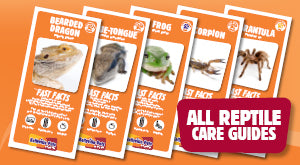 This comprehensive care guide will show you how to look after a Salamander in 3 easy steps
This comprehensive care guide will show you how to look after a Salamander in 3 easy steps
Fast Facts:
How long will my Salamander live? They can live from 6-8 years
How big will my Salamander grow? They will grow 15-20cm
What size of tank is recommended for my Salamander? They require a glass terrarium of at least 60 x 45 x 45cm
What does a Salamander eat? - Crickets, woodies and silkworms
How easy is it to look after a Salamander? They are a medium maintenance pet

Salamander Housing
Glass reptile enclosures are ideal for housing salamanders as they are water proof and have adequate ventilation. An enclosure approximately 60x45x5cm would be suitable for housing 1-2 adult salamanders.
Salamanders are ‘fossorial’, meaning they love to dig and burrow.
An organic substrate is required, such as coco-fibre or sphagnum moss. The substrate should be kept slightly damp to maintain humidity levels, and a moisture gradient should be present to allow the salamander to osmoregulate.
A small hide is essential for salamanders, and a shallow water dish should always be available with clean water. Water must be treated with water conditioner before being placed in the enclosure to remove harmful chlorine and other chemicals.
It is important to ensure that any rocks or gravel used are of a size that cannot be swallowed; ingestion of gravel can occur during feeding, and results can be fatal.
Salamander Care
Salamanders prefer a cooler temperature range of 18-22˚C. Excessive temperatures should be avoided; temperatures over 25˚C for an extended period of time can be potentially life threatening.
Being nocturnal, salamanders do not require any UV lighting, however low-light LED lighting can be used for viewing purposes.
Water should be changed when soiled, or every few days with dechlorinated tap water. The enclosure should be spot cleaned on a daily basis, with any poos or uneaten dead food removed. Sides of the enclosure should be wiped down 2-3 times a week to maintain a clean environment, and full substrate change should be done every 2-3 months, dependent on how many salamander inhabit the enclosure.
Handling of salamanders should be avoided, as their skin is semi-permeable and they can easily pick up detergents, toxins or other nasty residues that may be on our hands.
Salamander Feeding
Salamanders can eat a range of live insects including crickets, wood roaches, earth worms and silkworms.
Any insects given should first be coated with a calcium and vitamin supplement.
Salamanders should be fed at least twice a week using feeding tongs to offer the items of food. Pinky mice may also be offered as an occasional treat, however should not be used as a steady diet due to their high fat content.
Any uneaten insects or leftover food items should be removed from the enclosure daily to prevent injury to the salamander.

Did You Know!
Salamanders are the adult form of an axolotl.
Young axolotls undergo the process of metamorphosis, where they lose their gills, develop lungs and emerge from the water to live on land.
We have created a Shopping list to show what you need to look after a Salamander:
- Enclosure; 60 x 45 x 45cm minimum
- Water bowl
- Substrate
- Cave hide
- Artificial plants
- Thermometer
- LED lighting (optional)
- Water conditioner
- Crickets
- Woodies
- Silkworms
- Calcium and Vitamin supplement powder
- Feeding tongs
Common health issues in Salamanders
Fungal Diseases: Salamanders can develop fungal skin infections if poor husbandry practices are in place and their enclosure is not properly cleaned.
Metabolic Bone Disease: Calcium or vitamin D3 deficiency as a result of incorrect diet.
Chemical Toxicity: Salamanders are extremely sensitive to chemicals due to their semi-permeable skin. This means they should never be exposed to chlorine, disinfectants, fly sprays, deodorants or perfumes.
Red flags
Is your Salamander showing any of the signs of disease or illness? If yes, please consult your reptile vet.



At Kellyville Pets, we encourage responsible pet ownership.
CARE GUIDE © Copyright 2016 Kellyville Pets - All information found in this care guide is based upon our own experience. The information provided is not the only information available. In any medical situations, you should always consult your vet, including questions regarding your pet's diet.





 This comprehensive care guide will show you how to look after a Salamander in 3 easy steps
This comprehensive care guide will show you how to look after a Salamander in 3 easy steps


